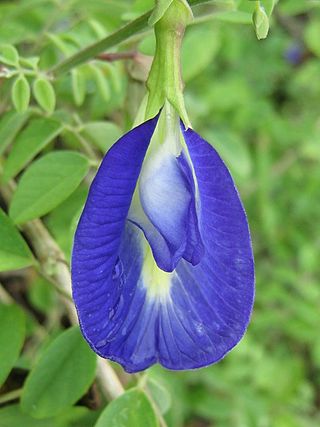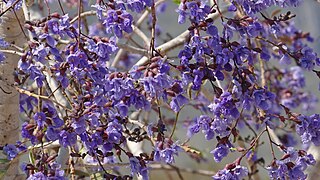
Bauhinia is a large genus of flowering plants in the subfamily Cercidoideae and tribe Bauhinieae, in the large flowering plant family Fabaceae, with a pantropical distribution. The genus was named after the Bauhin brothers Gaspard and Johann, Swiss-French botanists.

Catechin is a flavan-3-ol, a type of secondary metabolite providing antioxidant roles in plants. It belongs to the subgroup of polyphenols called flavonoids.

Phyllanthus is the largest genus in the plant family Phyllanthaceae. Estimates of the number of species in this genus vary widely, from 750 to 1200. Phyllanthus has a remarkable diversity of growth forms including annual and perennial herbs, shrubs, climbers, floating aquatics, and pachycaulous succulents. Some have flattened leaflike stems called cladodes. It has a wide variety of floral morphologies and chromosome numbers and has one of the widest range of pollen types of any seed plant genus.

Calliandra is a genus of flowering plants in the pea family, Fabaceae, in the mimosoid clade of the subfamily Caesalpinioideae. It contains about 140 species that are native to tropical and subtropical regions of the Americas.

The plant tribe Phaseoleae is one of the subdivisions of the legume subfamily Faboideae, in the unranked NPAAA clade. This group includes many of the beans cultivated for human and animal food, most importantly from the genera Glycine, Phaseolus, and Vigna.

Clitoria is a genus of mainly tropical and subtropical, insect-pollinated flowering pea vines.

Senna, the sennas, is a large genus of flowering plants in the legume family. This diverse genus is native throughout the tropics, with a small number of species in temperate regions. The number of species is estimated to be from about 260 to 350. The type species for the genus is Senna alexandrina. About 50 species of Senna are known in cultivation.

Andira is a genus of flowering plants in the legume family, Fabaceae. It is distributed in the tropical Americas, except for A. inermis, which also occurs in Africa. It was formerly assigned to the tribe Dalbergieae, but molecular phylogenetic studies in 2012 and 2013 placed it in a unique clade within subfamily Faboideae named the Andira clade.
Macropsychanthus schimpffii is a species of legume in the family Fabaceae. It is found only in Ecuador. Its natural habitat is subtropical or tropical moist lowland forests.

Ormosia is a genus of legumes. 131 living species, mostly trees or large shrubs, are native to the tropical Americas, from southwestern Mexico to Bolivia and southern Brazil, to southern, southeastern, and eastern Asia, and to New Guinea and Queensland. Most are tropical, while some extend into temperate regions of China. A few species are threatened by habitat destruction, while the Hainan ormosia is probably extinct already.

Macropsychanthus grandiflorus is a species of legume native to South America. The seeds of Macropsychanthus grandiflorus contain a well-characterized lectin named DGL which is similar to other legume lectins.

Bowdichia is a genus of flowering plants in the legume family, Fabaceae. It belongs to the subfamily Faboideae. The genus includes two species native to tropical South America and Costa Rica.
Cleobulia is a genus of flowering plants in the family Fabaceae. It belongs to subfamily Faboideae. It includes four species of vines, lianas, or shrubs native to southwestern Mexico and Brazil. Habitats include Amazon rainforest, seasonally dry forest, and montane oak and pine forest.

Cymbosema is a genus of flowering plants in the legume family, Fabaceae. It includes a single species, Cymbosema roseum, a liana native to the tropical Americas. It ranges from southeastern Mexico to Bolivia and northeastern and west-central Brazil. Typical habitats include tropical lowland rain forest and riverine forest.

Macropsychanthus is a genus of flowering plants in the legume family, Fabaceae. It belongs to the tribe Diocleae, subfamily Faboideae. The genus has 47 species with a pantropical distribution, ranging through the tropical Americas from southern Mexico to northeastern Argentina, west and central Africa, Madagascar, Indochina, Malesia, Papuasia, and Queensland.

Prodelphinidin is a name for the polymeric tannins composed of gallocatechin. It yields delphinidin during depolymerisation under oxidative conditions.

The tribe Diocleae is one of the subdivisions of the plant family Fabaceae.

Libidibia is a genus of flowering plants in the family Fabaceae. It includes seven species of trees and shrubs native to the tropical Americas, ranging from northern Mexico to northern Argentina. Typical habitats include seasonally-dry tropical forest and scrub, thorn forest, and savanna woodland. It belongs to the subfamily Caesalpinioideae.
Macropsychanthus megacarpus is a species of flowering plant in the family Fabaceae, native to Central America, Colombia, Peru, Bolivia, northern Brazil, Trinidad and Tobago, and the Windward Islands. A climber, it is typically found in wet tropical rainforests. Its seeds contain large amounts of the non-proteinogenic amino acid L-canavanine.















